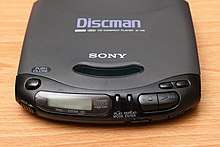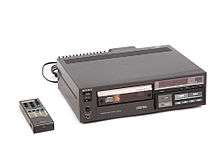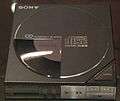Discman
Discman was Sony's brand name for portable CD players. The first Discman, the D-5 (North America and various other countries)/D-50, was released in 1984. In 1997 the name was changed to CD Walkman (Overseas model called Discman ESP2 until 1999[1]) worldwide to match cassette Walkman branding. [2]

.jpg)
Prior to release
Prior to the development of the CD, cassette tapes were the dominant form of audio storage in regards to the then-fledgling portable audio industry. In 1979, Sony had introduced the Walkman in Japan. As Sony began to realize the potential of the CD, executives pushed for a means to give the CD player market momentum, moving it from audio enthusiasts to the mainstream.
Development

Building on the design of the CDP-101 CD player, which was launched in 1982,[3] Sony worked towards both improving the design of the player, reducing the power and number of parts needed while decreasing the overall size of the player, as well as reducing the cost of the player to a 50 000 - 60 000 yen range in what was called the "CD CD Project", which stood for Compact Disc Cost Down Project. With the ability to produce a CD player one-tenth the size of its first unit by August 1983, there became potential for a portable player.
The original goal was to create a player that was the equivalent size of four CD cases stacked on top of each other. A piece of wood 13.4 cm across and about 4 cm thick was shown to the staff to illustrate the physical dimensions for which they were aiming. The finalised design did not incorporate a power source and so had a 9V (positive outer) coaxial jack on the rear. This allowed for the use of a wall adapter, the EBP-9LC, a carrying sleeve which held 6 primary C cells or rechargeable cells with the ability to charge in-situ. Alternatively, the AC D50 was available which attached to the rear of the D50 / D5 and allowed it to be powered from AC at 110/120/220/240 V 50/60 Hz 9 W with a DC output of up to 500 mA. The AC D50 also allowed line level audio out, presented as two RCA jacks.
Release
The D-50 (D-5 in some markets, including North America) was released in November 1984, two years after mass production of CDs began. The unit offered the same functionality as the full-size CDP-101 player, but came without a remote and the repeat functionality of the full-size unit. The D-50 retailed for 49,800 yen ($350 in 1984), approximately half the cost price of the CDP-101. The unit successfully sparked public interest in CDs, boosting their popularity, and within a year and a half the D-50 became profitable.
Because of its portable nature and similarity to the Walkman, the nickname 'Discman' was given to the D-50. This name has been used to refer to any Sony portable CD player. However, Sony has since changed the name to CD Walkman, starting in the late 1990s.
Impact
The release of the D-50 sparked public interest in CDs as an audio format and in the audio industry in general. A portable CD market was created and the price of competing CD players from other manufacturers dropped. The CD industry experienced sudden growth with the number of CD titles available dramatically increasing.
Intelligent Discman
"Intelligent Discman" was a line of Discman players that played CD-i format discs, which was owned by Philips.[4]
Sony D-50 gallery
 Sony Discman D-50
Sony Discman D-50- The original Sony D50/D5 Discman from 1984 Main PCB with rear cover removed.
- Sony D-50 with optional rechargeable battery station.
- The original Sony D50/D5 Discman from 1984 with PCB flipped up.
See also
References
- Notes
- SONY Discman D-E885 CD compact player
- "Sony Celebrates Walkman 20th Anniversary". Sony Press Release. Retrieved 2009-05-04.
- hifiengine.com 2020, Sony CDP-101, retrieved 31 May 2020.
- https://smallmart.nl/artikelen/vintage-computers/68-sony-portable-cd-i-player-the-intelligent-discman
- Sources
- "Sony History". Sony Electronics Inc. 2016. Retrieved April 11, 2016.
- "Sony Walkman Personal Stereo Turns 20 Years Old". Sony Electronics Inc. April 5, 1999. Archived from the original on July 20, 2009. Retrieved April 11, 2016.
External links
| Wikimedia Commons has media related to Sony Discman. |
- Jarman, Tim; Jarman, Nick (2016). "Walkman Central". - Reference site containing details and pictures of various Discman and Walkman models.
- "EEVblog #863 - Sony D50 Discman Teardown - World's First Portable CD Player". EEV Blog (YouTube). March 28, 2016.
